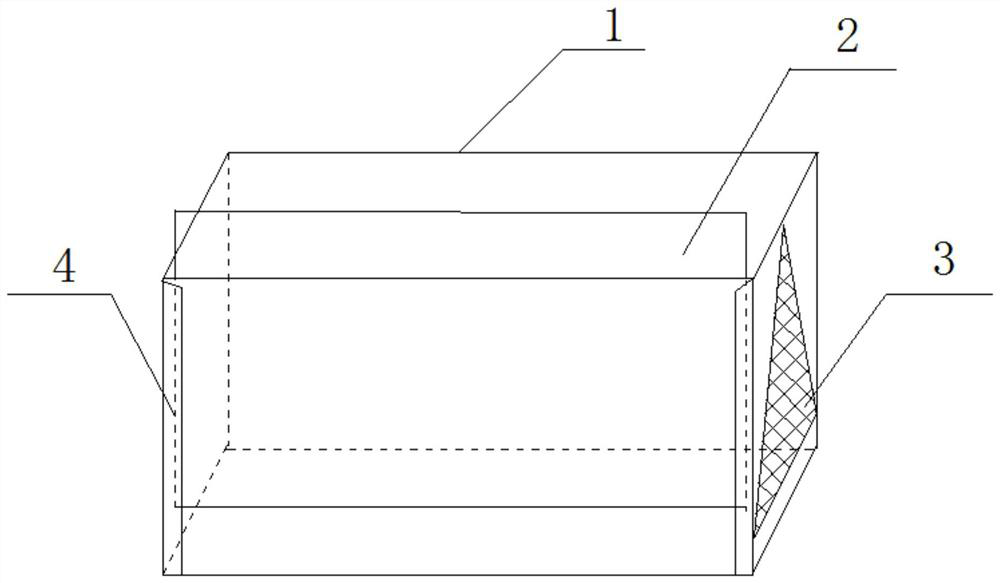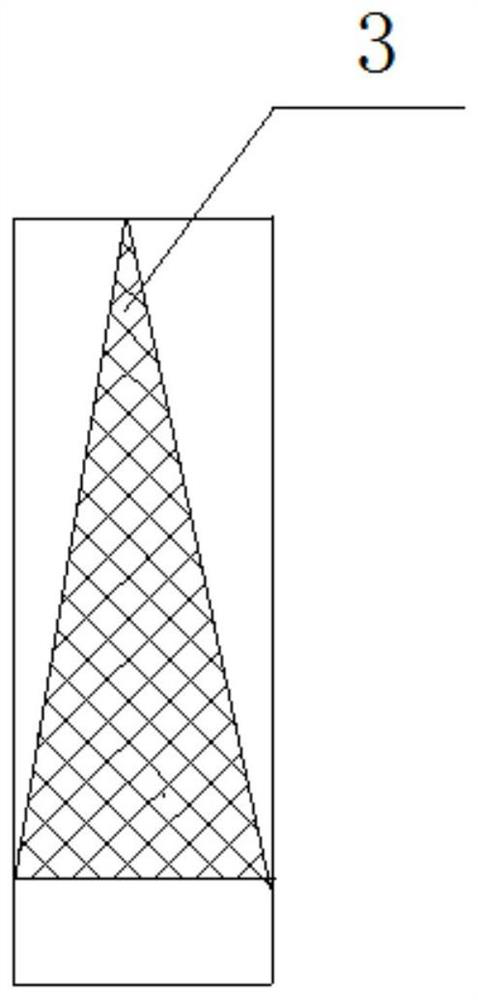Traditional Chinese medicine seedling bed and seedling method thereof
A technology for seedling beds and traditional Chinese medicine, applied in planting beds, botanical equipment and methods, root crop cultivation, etc., can solve the problems of easy soil compaction, poor soil ventilation, and being eaten by small animals.
- Summary
- Abstract
- Description
- Claims
- Application Information
AI Technical Summary
Problems solved by technology
Method used
Image
Examples
Embodiment 1
[0028] Lu Codonopsis Seedlings
[0029] Such as figure 1 , figure 2 As shown, a traditional Chinese medicine nursery bed includes a three-sided rectangular bed body 1 and a baffle plate 2, and gauze nets 3 are arranged on both sides of the rectangular bed body 1 to facilitate drainage when watering is too much; Two vertical edges on one side of the hollow surface of the body 1 are provided with baffle plates 4, and the baffle plate 2 is inserted into the hollow surface of the rectangular bed body 1 through the baffle plates 4 to form a rectangular seedling bed.
[0030] In this embodiment, the method for raising seedlings of Lu Codonopsis using the above-mentioned traditional Chinese medicine nursery bed specifically includes the following steps:
[0031] (1) Site selection and preparation: The nursery bed is selected in a large field plot with deep soil, ventilated light and good drainage, and the first crop is selected from corn and other gramineous crops; choose the north-south ...
Embodiment 2
[0041] Bupleurum seedlings
[0042] (1) Site selection and preparation: the nursery bed should be selected in a field plot with deep soil, ventilated light and good drainage. The first crop should be leguminous crops; choose southwest direction, digging width 17cm, depth 25cm, sloping around A trapezoidal pit with a length of about 15 degrees and the length depends on the actual situation, and the distance between the pits is 27cm;
[0043] (2) Planting of shade crops: First plant broad beans around the nursery bed with a plant spacing of 8-10cm. Seedlings can emerge within 15 days after sowing, and buds and branches can be seen in 30 days to achieve shading effect. Bupleurum seeds relies on broad bean plants to shade and avoid direct sunlight within one month after emergence of Bupleurum seedlings, and then cut broad beans to facilitate the lighting of Bupleurum seedlings; at the end of October, the aboveground stems and leaves of broad beans will directly cover the seedbed;
[004...
Embodiment 3
[0052] Astragalus seedlings
[0053] (1) Site selection and preparation: The nursery bed is selected in a field plot with deep soil, ventilated light, and good drainage. The first crop is gramineous; choose the southwest direction, digging width 17cm, depth 25cm, sloping around A trapezoidal pit with a length of about 15 degrees and a length according to the actual situation. The distance between the pit and the pit is 30cm;
[0054] (2) Planting of shade crops: first plant tartary buckwheat around the nursery bed with a plant spacing of 6cm. Seedlings can emerge after 15 days of sowing, and buds and branches can reach the sunshade effect after 25 days. Rely on the tartary buckwheat plant for shading and avoid direct sunlight within 1 month after the seedlings of Scutellaria baicalensis Georgi, and then shorten the tartary buckwheat seedlings to facilitate the lighting of the seedlings; at the end of October, the aboveground stems and leaves of tartary buckwheat will directly cover...
PUM
| Property | Measurement | Unit |
|---|---|---|
| Thickness | aaaaa | aaaaa |
| Thickness | aaaaa | aaaaa |
| Thickness | aaaaa | aaaaa |
Abstract
Description
Claims
Application Information
 Login to View More
Login to View More - R&D
- Intellectual Property
- Life Sciences
- Materials
- Tech Scout
- Unparalleled Data Quality
- Higher Quality Content
- 60% Fewer Hallucinations
Browse by: Latest US Patents, China's latest patents, Technical Efficacy Thesaurus, Application Domain, Technology Topic, Popular Technical Reports.
© 2025 PatSnap. All rights reserved.Legal|Privacy policy|Modern Slavery Act Transparency Statement|Sitemap|About US| Contact US: help@patsnap.com


